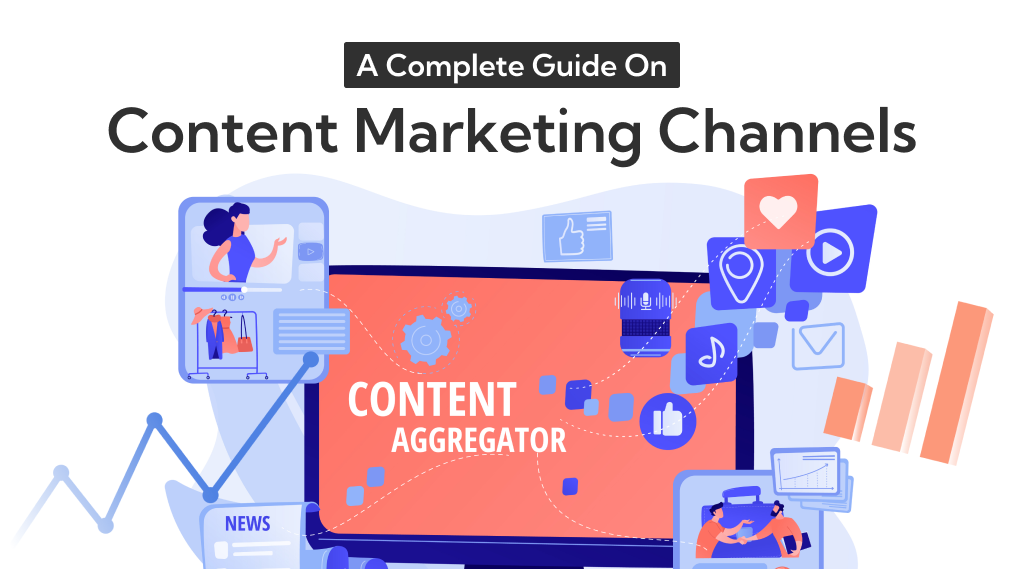Introduction
Content marketing isn’t just about creating compelling narratives; it’s about strategically sharing, publishing, and promoting your material across a variety of platforms to maximize reach and engagement.
Before creating a content you should know where and how you’re going to publish and promote your content before you put your words to paper. Otherwise, your time and resources could go to waste.
With 60% of marketers creating daily content and platforms like Twitter buzzing with thousands of tweets per second, the digital world is awash in information.
Yet, as Google processes over 8.5 billion searches daily, the main challenge still exist that is getting through this highly saturated market of content.
In this article we will learn about the basics of content marketing channels, its types and tips to frame a full-proof content strategy using different channels. Let us dive in!
What is a content marketing channel?
Content marketing channels refer to the diverse platforms and mediums through which businesses and individuals distribute their content to reach and engage their target audience.
These channels are crucial components to form a successful creative content marketing strategy, as they determine how content reaches its intended audience and the effectiveness of that reach.
What are the types of content marketing channels?
Let’s understand how businesses effectively navigate these channels to meet their overarching objectives:
- Blogging: In-depth exploration and education
- Social media: Multi-platform management
- Email marketing: Targeted communication
- Video content: visual storytelling
- Podcast: Auditory exploration
- Webinars and live events: Real-time interaction
- Interactive content: Engaging experiences
1. Blogging: In-depth exploration and education
Blogging remains a foundational content marketing channel, exemplified by platforms like WordPress and Medium. Brands utilize blogs to delve into industry trends, provide educational resources, and establish thought leadership.
Through well-crafted articles, businesses not only showcase their expertise but also improve search engine visibility, driving organic traffic to their websites.
2. Social media: Multi-platform engagement
Social media platforms such as Facebook, Instagram, Twitter, LinkedIn, and Pinterest serve as versatile channels for content distribution. Brands tailor their content to each platform’s unique features, utilizing visual storytelling, short-form content, and interactive elements to engage diverse audiences.
Social media facilitates real-time interaction, allowing businesses to build communities, share updates, and receive immediate feedback.
3. Email marketing: Targeted communication
Email marketing, exemplified by platforms like Mailchimp and Constant Contact, enables businesses to deliver targeted and personalized content directly to their audience’s inboxes. Examples include newsletters, product updates, and exclusive offers.
By segmenting email lists and analyzing recipient behavior, businesses can refine their content strategy, nurturing leads and maintaining ongoing communication with customers.
4. Video content: Visual storytelling
Video content, showcased on platforms like YouTube, TikTok, and Vimeo, caters to the visual preferences of modern audiences. Brands create diverse video content, including tutorials, product demonstrations, vlogs, and behind-the-scenes glimpses.
5. Podcasting: Auditory exploration
Podcasting has gained popularity as an on-the-go content medium. Platforms like Apple Podcasts and Spotify host a myriad of podcasts covering various topics.
Brands leverage podcasting to engage auditory audiences through interviews, discussions, and storytelling. Podcasts offer a convenient and intimate way to connect with listeners, making it an ideal channel for niche content and industry insights.
6. Webinars and live events: Real-time interaction
Webinars and live events, facilitated by platforms like Zoom and GoToWebinar, provide real-time interaction with audiences. Brands use this channel for in-depth discussions, product launches, and Q&A sessions.
The live format allows for immediate engagement, fostering a sense of community and authenticity. Recordings can also be repurposed as on-demand content, extending the reach beyond the live audience.
7. Interactive content: Engaging experiences
Interactive content, including quizzes, polls, and surveys, adds a dynamic dimension to content marketing. Platforms like Outgrow and Typeform enable businesses to create engaging and shareable interactive experiences.
This channel encourages audience participation, providing valuable insights for brands while creating memorable and shareable content experiences.
Incorporating a mix of these content marketing channels into a comprehensive strategy allows businesses to reach diverse audiences, cater to different preferences, and create a cohesive brand presence across the digital landscape.
The key lies in understanding the unique strengths of each channel and aligning them with specific marketing goals and target audience preferences.
How to identify which content marketing channel works for you?
Identifying the most effective content marketing channel for your business requires a strategic and data-driven approach. Here’s a comprehensive guide to help you navigate the process:
- Understand your audience
- Set clear goals
- Analyze your content
- Assess competitor strategies
- Leverage analytics tools
- Conduct A/B testing
- Consider the Buyer’s journey
- Budget and resources
- Stay flexible and iterative
- Seek feedback
1. Understand your audience:
Begin by developing a deep understanding of your target audience. Who are they? What are their preferences, behaviors, and challenges? Conduct thorough market research and gather customer insights to create detailed buyer personas.
Knowing your audience is fundamental to selecting channels that resonate with them.
2. Set clear goals:
Establish specific and measurable goals for your content marketing efforts. Whether it’s brand awareness, lead generation, customer retention, or sales, having clear objectives will guide your channel selection. Different channels are better suited for specific goals, so align your choices with your overarching business objectives.
3. Analyze your content:
Review your existing content to identify its strengths and weaknesses. Understand what type of content has performed well in the past and on which platforms.
Consider the format (blog posts, videos, infographics) and the topics that have resonated with your audience. This analysis provides valuable insights into the content types and channels that are likely to be successful.
4. Assess competitor strategies:
Examine the content marketing strategies of your competitors. Identify the channels they are using and analyze their success metrics. This competitive analysis can offer valuable insights into industry trends and help you identify gaps or opportunities in the market.
5. Leverage analytics tools:
Utilize analytics tools to measure the performance of your current content across different channels. Google Analytics, social media analytics, and email marketing analytics provide data on metrics such as traffic, engagement, conversion rates, and more.
Analyzing this data can help you identify which channels are driving the most meaningful results.
6. Conduct A/B testing:
Experiment with A/B testing to compare the performance of different content on various channels. This could involve testing different headlines, visuals, or even entire pieces of content.
A/B testing allows you to refine your content strategy based on real-time feedback, helping you understand what resonates best with your audience.
7. Consider the Buyer’s journey:
Map out your customer’s journey from awareness to conversion. Different channels may be more effective at different stages of the buyer’s journey.
For example, social media might be great for building awareness, while email marketing could be more effective for nurturing leads. Align your channel selection with the various touchpoints of the buyer’s journey.
8. Budget and resources:
Evaluate your budget and available resources. Some channels may require more financial investment or manpower than others.
Consider the long-term sustainability of your chosen channels in terms of both cost and resource allocation.
9. Stay flexible and iterative:
The digital landscape is dynamic, and audience preferences evolve. Stay flexible and be willing to adapt your strategy based on changing trends and emerging channels.
Regularly reassess the performance of your chosen channels and be prepared to shift focus if necessary.
10. Seek feedback:
Engage with your audience directly to gather feedback. Conduct surveys, encourage comments on your content, and listen to social media conversations.
Understanding the preferences and feedback of your audience can provide valuable insights into which channels are resonating with them.
In conclusion, identifying the right content marketing channel involves a combination of understanding your audience, setting clear goals, analyzing data, and staying agile in response to feedback and industry changes.
By taking a strategic and data-driven approach, you can optimize your content marketing efforts for maximum impact and ROI.
Here is how you should calculate your content marketing ROI for saas
Conclusion
Understanding and effectively utilizing content marketing channels is crucial for engaging your audience and driving your brand’s message. As we’ve explored in this guide, each channel offers unique advantages and opportunities for creativity and connection.
By carefully selecting and optimizing these platforms, you can ensure your content reaches the right people at the right time, maximizing impact and driving success.
Ready to supercharge your creative content marketing strategy? Partner with us to elevate your brand, increase user acquisition, and boost conversions. Let’s accelerate your success together. Visit revvgrowth.com now and ignite your SaaS growth journey!


